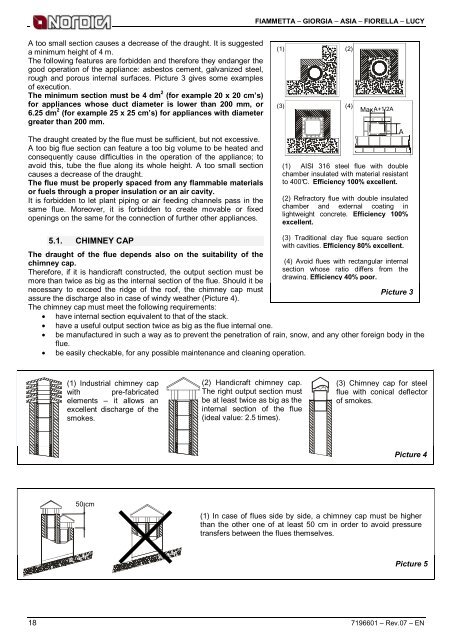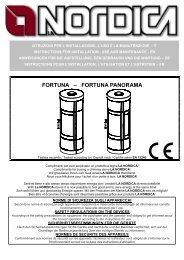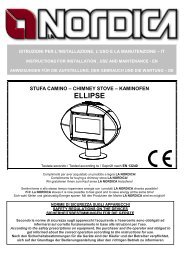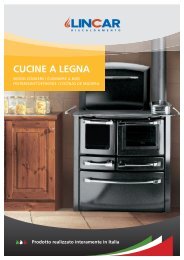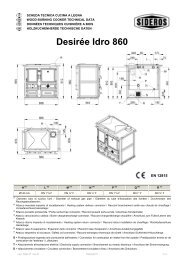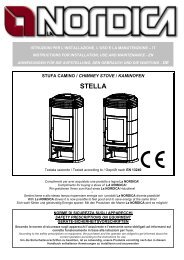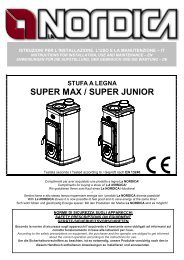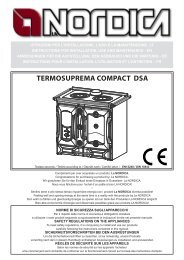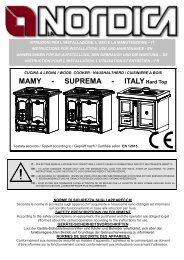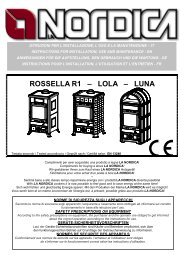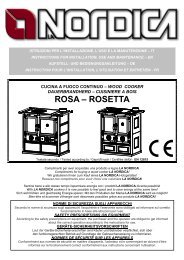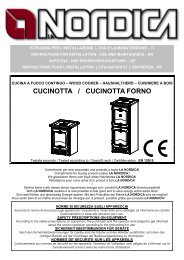FIAMMETTA - ASIA – GIORGIA – FIORELLA - LUCY
FIAMMETTA - ASIA – GIORGIA – FIORELLA - LUCY
FIAMMETTA - ASIA – GIORGIA – FIORELLA - LUCY
Create successful ePaper yourself
Turn your PDF publications into a flip-book with our unique Google optimized e-Paper software.
A too small section causes a decrease of the draught. It is suggested<br />
a minimum height of 4 m.<br />
The following features are forbidden and therefore they endanger the<br />
good operation of the appliance: asbestos cement, galvanized steel,<br />
rough and porous internal surfaces. Picture 3 gives some examples<br />
of execution.<br />
The minimum section must be 4 dm 2 (for example 20 x 20 cm’s)<br />
for appliances whose duct diameter is lower than 200 mm, or<br />
6.25 dm 2 (for example 25 x 25 cm’s) for appliances with diameter<br />
greater than 200 mm.<br />
The draught created by the flue must be sufficient, but not excessive.<br />
A too big flue section can feature a too big volume to be heated and<br />
consequently cause difficulties in the operation of the appliance; to<br />
avoid this, tube the flue along its whole height. A too small section<br />
causes a decrease of the draught.<br />
The flue must be properly spaced from any flammable materials<br />
or fuels through a proper insulation or an air cavity.<br />
It is forbidden to let plant piping or air feeding channels pass in the<br />
same flue. Moreover, it is forbidden to create movable or fixed<br />
openings on the same for the connection of further other appliances.<br />
5.1. CHIMNEY CAP<br />
The draught of the flue depends also on the suitability of the<br />
chimney cap.<br />
Therefore, if it is handicraft constructed, the output section must be<br />
more than twice as big as the internal section of the flue. Should it be<br />
necessary to exceed the ridge of the roof, the chimney cap must<br />
assure the discharge also in case of windy weather (Picture 4).<br />
The chimney cap must meet the following requirements:<br />
• have internal section equivalent to that of the stack.<br />
• have a useful output section twice as big as the flue internal one.<br />
<strong>FIAMMETTA</strong> <strong>–</strong> <strong>GIORGIA</strong> <strong>–</strong> <strong>ASIA</strong> <strong>–</strong> <strong>FIORELLA</strong> <strong>–</strong> <strong>LUCY</strong><br />
Picture 3<br />
• be manufactured in such a way as to prevent the penetration of rain, snow, and any other foreign body in the<br />
flue.<br />
• be easily checkable, for any possible maintenance and cleaning operation.<br />
(1) Industrial chimney cap<br />
with pre-fabricated<br />
elements <strong>–</strong> it allows an<br />
excellent discharge of the<br />
smokes.<br />
50 cm<br />
(1) (2)<br />
Max. A+1/2A<br />
A+1/2A<br />
Picture 4<br />
Picture 5<br />
18 7196601 <strong>–</strong> Rev.07 <strong>–</strong> EN<br />
(3)<br />
(2) Handicraft chimney cap.<br />
The right output section must<br />
be at least twice as big as the<br />
internal section of the flue<br />
(ideal value: 2.5 times).<br />
(4)<br />
(1) AISI 316 steel flue with double<br />
chamber insulated with material resistant<br />
to 400°C. Efficiency 100% excellent.<br />
(2) Refractory flue with double insulated<br />
chamber and external coating in<br />
lightweight concrete. Efficiency 100%<br />
excellent.<br />
(3) Traditional clay flue square section<br />
with cavities. Efficiency 80% excellent.<br />
(4) Avoid flues with rectangular internal<br />
section whose ratio differs from the<br />
drawing. Efficiency 40% poor.<br />
(3) Chimney cap for steel<br />
flue with conical deflector<br />
of smokes.<br />
(1) In case of flues side by side, a chimney cap must be higher<br />
than the other one of at least 50 cm in order to avoid pressure<br />
transfers between the flues themselves.<br />
A


